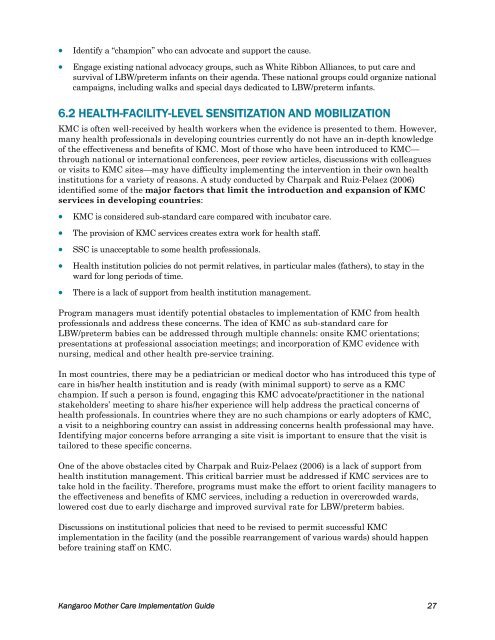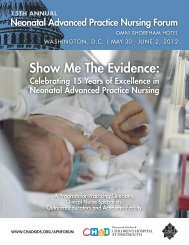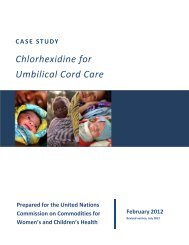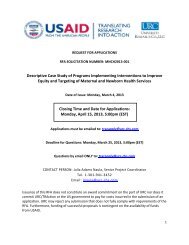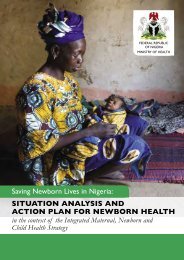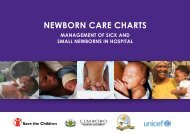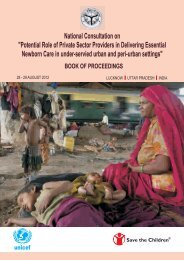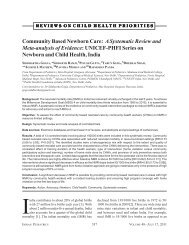Kangaroo Mother Care - MCHIP
Kangaroo Mother Care - MCHIP
Kangaroo Mother Care - MCHIP
You also want an ePaper? Increase the reach of your titles
YUMPU automatically turns print PDFs into web optimized ePapers that Google loves.
Identify a “champion” who can advocate and support the cause.<br />
Engage existing national advocacy groups, such as White Ribbon Alliances, to put care and<br />
survival of LBW/preterm infants on their agenda. These national groups could organize national<br />
campaigns, including walks and special days dedicated to LBW/preterm infants.<br />
6.2 HEALTH-FACILITY-LEVEL SENSITIZATION AND MOBILIZATION<br />
KMC is often well-received by health workers when the evidence is presented to them. However,<br />
many health professionals in developing countries currently do not have an in-depth knowledge<br />
of the effectiveness and benefits of KMC. Most of those who have been introduced to KMC—<br />
through national or international conferences, peer review articles, discussions with colleagues<br />
or visits to KMC sites—may have difficulty implementing the intervention in their own health<br />
institutions for a variety of reasons. A study conducted by Charpak and Ruiz-Pelaez (2006)<br />
identified some of the major factors that limit the introduction and expansion of KMC<br />
services in developing countries:<br />
<br />
<br />
<br />
<br />
<br />
KMC is considered sub-standard care compared with incubator care.<br />
The provision of KMC services creates extra work for health staff.<br />
SSC is unacceptable to some health professionals.<br />
Health institution policies do not permit relatives, in particular males (fathers), to stay in the<br />
ward for long periods of time.<br />
There is a lack of support from health institution management.<br />
Program managers must identify potential obstacles to implementation of KMC from health<br />
professionals and address these concerns. The idea of KMC as sub-standard care for<br />
LBW/preterm babies can be addressed through multiple channels: onsite KMC orientations;<br />
presentations at professional association meetings; and incorporation of KMC evidence with<br />
nursing, medical and other health pre-service training.<br />
In most countries, there may be a pediatrician or medical doctor who has introduced this type of<br />
care in his/her health institution and is ready (with minimal support) to serve as a KMC<br />
champion. If such a person is found, engaging this KMC advocate/practitioner in the national<br />
stakeholders’ meeting to share his/her experience will help address the practical concerns of<br />
health professionals. In countries where they are no such champions or early adopters of KMC,<br />
a visit to a neighboring country can assist in addressing concerns health professional may have.<br />
Identifying major concerns before arranging a site visit is important to ensure that the visit is<br />
tailored to these specific concerns.<br />
One of the above obstacles cited by Charpak and Ruiz-Pelaez (2006) is a lack of support from<br />
health institution management. This critical barrier must be addressed if KMC services are to<br />
take hold in the facility. Therefore, programs must make the effort to orient facility managers to<br />
the effectiveness and benefits of KMC services, including a reduction in overcrowded wards,<br />
lowered cost due to early discharge and improved survival rate for LBW/preterm babies.<br />
Discussions on institutional policies that need to be revised to permit successful KMC<br />
implementation in the facility (and the possible rearrangement of various wards) should happen<br />
before training staff on KMC.<br />
<strong>Kangaroo</strong> <strong>Mother</strong> <strong>Care</strong> Implementation Guide 27


